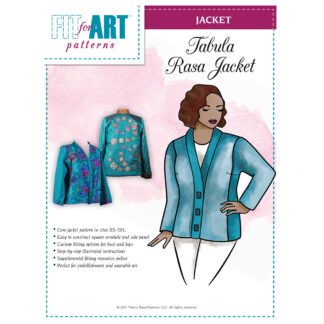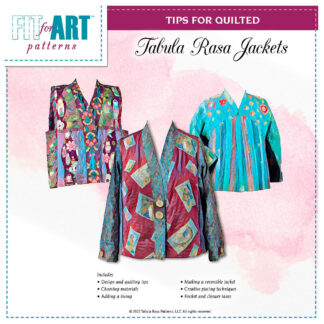
We are pleased to announce that we are giving the Tabula Rasa Jacket a bright new face! It was time to print more TRJ Instruction books, so we decided to put new art on the cover that is more consistent with the TRJ Variation covers. Many thanks to our excellent graphic artist, Erin Hillmar!

The content inside the book is much the same as before, with two great additions. For the thousands of you who already have a much-loved copy of the TRJ instruction book, we are sharing the new material here. Please pass this on to friends who might not be on the mailing list for our blog (and tell them to go to our website and subscribe so they won’t miss any more super tips and ideas).
Mixing Fabrics in a TRJ
As you no doubt know, we incorporate several fabrics in many of our jackets. For a booth freebie early on in our show life, we created a chart estimating the amount of fabric needed for each “unit” of a jacket. The chart has been available on our website as a Helpful Hint for some time. Click on this link to see it now: “Mixing Fabrics in a Tabula Rasa Jacket.” Now you will also find that chart on page 15 of the revised TRJ Instruction book.
Add a Shoulder Facing to an Unlined Jacket
A good number of our unlined TRJs feature a facing to support the shoulder area of the jacket, which gets some of the hardest wear in a jacket. A facing provides a prettier and sturdier finish than fusible interfacing applied directly to the shoulder area. It can also be a fun way to use small pieces of contrasting or coordinating fabrics. Here are photos of the shoulder facing in an unlined jacket. In the first sample, I made the facing a bit longer than typical (the length of the upper HBL) to match the back yoke on the jacket. In the second sample, Rae used some great leftover borders from one of the fabrics for the facings and the inside of the front band.
To create the facing:
- Trace your front and back pattern pieces above the upper horizontal balance line (or extend it below the HBL if you prefer) onto pattern paper. Cut them out, labeling both pieces.

Trace the facing - Use the facing patterns to cut two front and one back facing from your facing fabric and from fusible interfacing. The facing fabric can be the same as the jacket body, a contrasting or coordinating fabric, or a silky lining fabric. Fuse the interfacing to the facings.
- Sew fronts to back at the shoulder seams. Press seams open.
- Clean finish the lower edges of the facings with a serger, zigzag stitch, or by turning under ¼” and topstitching it down.
To insert the facing:
- Insert the facing at Step 4 of the jacket construction after sewing the jacket body’s shoulder seams together and pressing them open.
- Lay the jacket body on a table, wrong side up. Place the facing on the jacket, wrong sides together, matching shoulder seams.
- Baste facing into place along the neck edge and armholes.
- Proceed to the sleeve/side unit as usual.
It’s that easy! Have you used this technique already? If so, please send or post a photo to share with our community. If not, add a shoulder facing to an unlined TRJ that you are working on and let us know how it goes or send us a photo.
Happy Sewing, Carrie Emerson















What a thoughtful idea to add to an already fabulous pattern. Thank you both. Looking forward to more awesome ideas from you two. Have a great day.
Marsha